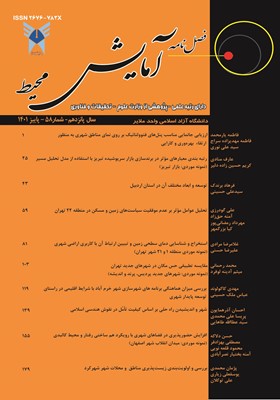ارزیابی جانمایی مناسب پنلهای فتوولتائیک بر روی نمای مناطق شهری بهمنظور ارتقاء بهرهوری و کارایی
محورهای موضوعی : آمایش محیط
فاطمه یارمحمد
1
,
فاطمه مهدیزاده سراج
2
*
![]() ,
سید علی نوری
3
,
سید علی نوری
3
1 - دکتری معماری، واحد تهران شمال، دانشگاه آزاد اسلامی، تهران، ایران
2 - دکتری معماری، استادتمام دانشگاه علم و صنعت،دانشکده معماری و شهرسازی،گروه معماری، تهران، ایران
3 - دکتری معماری، استادیار دانشگاه آزاد اسلامی، واحد تهران شمال،گروه معماری، تهران، ایران
کلید واژه: پنلهای فتوولتاییک, نمای ساختمان, سایبان, جانمایی و بهرهوری انرژی,
چکیده مقاله :
با توجه به بحران کمبود منابع انرژی و آلودگی های زیست محیطی، نیاز به استفاده از انرژی های جایگزین و تجدیدپذیر ضروری می باشد. این مهم منجر به گرایش روزافزون استفاده از سیستم های خورشیدی، از مهم ترین منابع انرژی تجدیدپذیر شده است. پنل های فتوولتاییک از جمله اصلی ترین و پرکاربردترین سیستم های فعال خورشیدی است که با توجه به محدود بودن فضای بام ساختمان ها جهت نصب، تلفیق آن با نمای ساختمان های شهری مورد توجه قرارگرفته است. در این مقاله ضمن بررسی عوامل تأثیرگذار بر بازدهی پنل هایBIPV[1] به بررسی تأثیر تلفیق پنل های فتوولتاییک با اجزای اصلی نما شامل جداره های شیشه ای بنا، نمای ساختمان و سایبان ها بر میزان بهره وری انرژی و مقایسه آن پرداخته شده است. جهت رسیدن به این هدف، یک ساختمان اداری در نرمافزارگرس هاپر شبیه سازی و با استفاده از پلاگین های هانی بی و لیدی باگ، پنل های فتوولتاییک در اجزای مختلف نمای جنوبی پیادهسازی و میزان بهره وری انرژی در هر یک از اجزا بررسی شد. همچنین سایر عوامل تأثیرگذار بر موقعیت نصب پنلها و میزان اثرگذاری آن شامل جانمایی، نوع، بازدهی، ضریب عبور نور، شفافیت و تنوع طرح، پوشش برف و باران، میزان هزینه و موجودی بازار بررسی و با استفاده از آنتروپی شانون وزن دهی و رتبه بندی شد. نتایج تحقیق نشان می دهد تلفیق پنل ها با مساحت یکسان به ترتیب با سایبان، بدنه اصلی نما و جدار شیشه ای بیشترین تأثیر را در بهره وری و کارایی انرژی دارد. [1] Building Integrated Photovoltaic
Due to the crisis of the lack of energy resources and environmental pollution, it is necessary to use alternative and renewable energy. This has led to a growing trend in the use of solar systems, one of the most important sources of renewable energy. Photovoltaic panels are one of the main applicable existing solar power systems. Due to the limited space in building roofs to install such panels, combining them with the façades of buildings has received enormous consideration. In this article, first, the effective factors in efficiency and productivity of BIPV¹ panels were evaluated; then, the effects of combining photovoltaic panels with the main façade components, including curtain walls, façades, and canopies, on energy efficiency were examined and compared. To reach the goal of this research, an office building was simulated in Grasshopper software; photovoltaic panels were installed in different components of its southern façade using Honeybee and Ladybug plugins, and the energy efficiency of each component was analyzed. Moreover, the other effective factors on the location of panels’ installation, including their layout, type, module energy efficiency, cost, variety of patterns, light transmission, market limitation, the optical quality of panels’ glass, and the effect of rainfall and snow cover, as well as their effectiveness level were studied, weighted, and ranked using the Shannon Entropy Approach. The results revealed that combining the panels with the same area by a canopy, the main body of the façade, and the curtain wall had the highest effects on energy efficiency, respectively.
_||_

